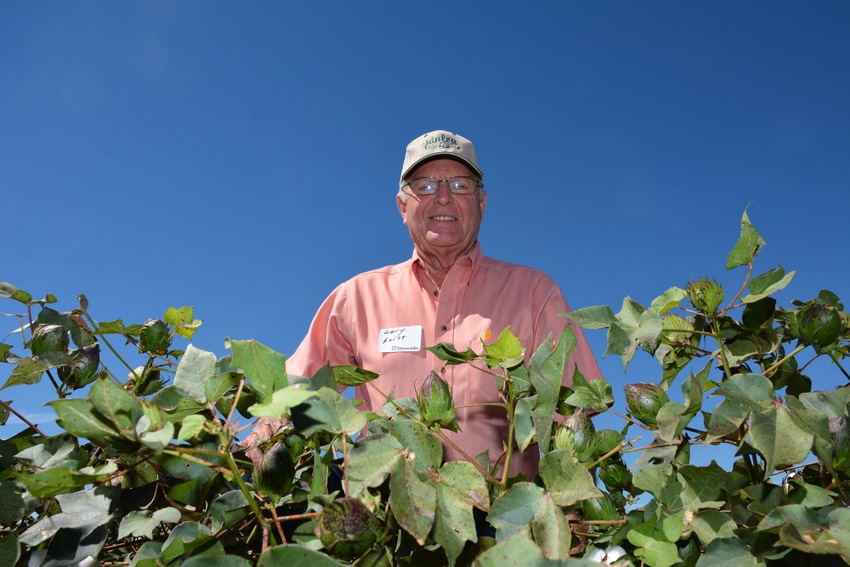
Gary Evitt’s cotton crop, just weeks away from harvest, reminds him of a line from an old Clint Eastwood movie: “It’s good, bad, and ugly.” That’s Evitt’s assessment of his crop, following a Bayer FiberMax field day held near one of his fields at Idalou, Texas.
“The difference is where it rained and where it didn’t, and where we have water and where we don’t,” he says. “I have some really good cotton, some that’s just in-between, and some that’s not so good.”
That includes irrigated acreage, acreage that’s irrigated but with light water, and dryland production that started off well with spring moisture, but suffered under hot, dry conditions in July and August.
Irrigated cotton should yield pretty well, he says.
Compounding the dryland problem was late summer rain that spurred regrowth on the stressed plants and was posing potential headaches with defoliation. “I’m just getting started on defoliation,” Evitt says, “and the dryland fields will be tough. I think we can kill it, but we may stick the leaves.”
He recalls one year when dryland cotton picked up small amounts of rainfall during the season. “We got a half inch, four-tenths inch, and six-tenths inch. The cotton wasn’t big, but it was loaded up. It rained in the fall, so we got a lot of regrowth and the leaves stuck.” He ran the tractor across the field with a tool bar set over the regrowth and knocked the leaves off. “It worked,” he says.
All in all, he’s not sure how his crop will fare.
RECOMMENDATIONS
Russ Perkins, who’s with Bayer, agrees that defoliating stressed dryland regrowth cotton will be a challenge. He offers some recommendations.
“If growers can get Ginstar, they should not apply less than 6 ounces per acre this late” he says. “We can’t use as low a rate as usual since we’re getting started so late. Also, think about using some of the PPO materials [Sharpen, Aim, and others] at appropriate rates. These have a place, and can be economical for fields of 1 bale dryland cotton. Ethephon may also be needed in some fields.
“Beyond that,” Perkins says, “a light rate of a paraquat product may help — but be careful not to stick leaves too quickly. We don’t have much else available, except some trial-and-error to see what works.”
For the latest on southwest agriculture, please check out Southwest Farm Press Daily and receive the latest news right to your inbox.
Gary Evitt has battled other problems, as well, including resistant pigweeds. “I use a lot of preplant herbicide, including Treflan, worked into the soil in two directions. I also use Direx and Caparol behind the planter, and then Warrant and Dual for more residual when I apply Liberty.”
He says Liberty works well, but timing and weather are critical. “Humidity makes a difference, and Liberty worked well early this season because we had early rainfall and good humidity. Weeds weren’t stressed, so the herbicide worked well on them.” He uses some Roundup, as well.
“We also cultivate. We spot hoe, and also run a knifing rig — some fields once, and others twice. We never got completely away from cultivation. I do use row furrow dikes to catch rain, so I‘ve had to break some of those with cultivation. We’re having to go back to the way we used to do it.”
He fights nematodes, too. “We have root knot nematodes on some farms. I used Temik before they took it away, and then Vydate until they took that away.”
NEMATODE MANAGEMENT
He plants a nematode-tolerant variety, FM 1911 GLT, to help manage the pest. “It has done well,” he says. He plants most acreage in FM 1830 and FM 2322, “mostly 2322.”
Evitt is doing all he can to manage a diminishing water resource. He has some subsurface drip irrigation, and is watering only partial circles on many of his pivot systems. “Some fields we water two-thirds, and some we water three-fourths. We probably need to cut some down to half circles.”
He plants underneath the entire pivot and manages part as dryland cotton. “We have to manage our water,” he says. “Our water sources are getting weaker.”
Evitt made his first crop in 1970, and says cotton has always been his primary crop. “We used to grow maize and rotate, but we just didn’t have enough water. We’ve always depended on cotton.”
He’d like to see the price move up a bit before the crop is finished. “Our irrigated cotton looks pretty good, but the price is off. We market through a pool, and I suspect they took advantage of the two summer rallies to book some cotton.”
About the Author(s)
You May Also Like






